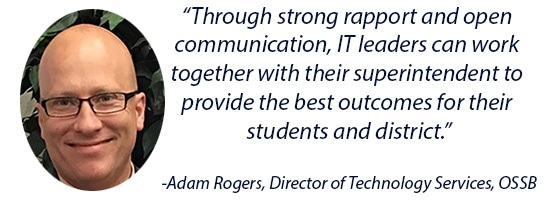Part of a Blog Series from the Emerging Technologies Committee Leveraging Technology for Improving School Wellness and Safety
School leaders are looking for ways to make their schools safer, and purchasing new technology is a route that many choose. The choice requires critical conversations around student privacy vs. safety. Decisions about whether to invest in school security technology for a school or school district are complex. They must take into account various logistical, economic, and political factors. There will never be a one-size-fits-all effort, and it should be noted that we cannot provide an overarching recommendation for districts. Only a conversation with some district leaders that are or are considering implementing technology based interventions to reduce school violence.
“The privacy of students is to be respected but not at the cost of a less safe learning environment, so we have to look for ways to monitor student interactions without crossing personal boundaries.” – Greg O’Dell, E-learning Specialist at Hall County (GA)
Most everyone interviewed had a district security team, including school security officers, principals who monitor alerts/threats, and student services. Notably, technology staff seem to have varying levels of involvement with security related decisions and technology purchases. Those with technology staff as part of their regular security team tended to have more advanced technology specific safety interventions. This is something that districts and schools should perhaps pay attention to. 
As more schools integrate school safety technologies, some areas that need additional consideration are:
- Who should drive purchasing decisions in relation to safety and security
- Whose responsibility is it to manage school safety technology
- Are technology based interventions more effective than other methods
- What are the privacy issues
- What are the bias concerns
The implementation of new technologies comes with some privacy considerations as well as potential bias. As the districts interviewed grapple with these decisions, they all rely on groups of stakeholders to come to their decisions.
“In general, the risk of bias is that we don’t look at the implementation of technology from all perspectives.” – Greg O’Dell, E-learning Specialist at Hall County (GA)
The following graphic demonstrates how school safety technology is rapidly changing. On the left hand side we have commonplace technology that has been used for decades in schools to protect students. On the right we have the new and upgraded technology that districts are currently considering purchasing to improve the safety of their students.

Monitoring student activity and communications
In addition to technologies that identify immediate threats, there is proactive software that identifies student behavior and flags it for intervention before the student decides to act with violence. Jessica Preisig, Assistant Superintendent for Technology Services at Pickens County Schools (SC), uses software supported by contracted specialists that do just that. The software identifies inappropriate messages using sentiment analysis and natural language processing and then prompts the student in real-time to automated interventions. They also recall harmful messages and quarantine inappropriate images and files. When school staff is needed, the contracted team of experts will alert school officials of bullying, violence, and danger to students and teachers 24/7. The district has had great success with the product as it analyzes a student’s well-being and notifies a teacher if it starts to drop.
“It has helped a lot of our students that were in need of help. Students that were thinking about harming themselves or others, we’ve been able help a lot of those students because we have this [product] in place.”
Another benefit Jessica sees is that principals are not inundated with every little incident since the software takes care of the minor ones and teachers are also alerted. The principal is now only getting involved when a student is really in need of support and help.
These conversations and decisions are not easy and will be challenging for administrators for years to come. Administrators need to be able to trust the IT department when it comes to the technology that is being put into schools. Having a positive and collaborative relationship with the superintendent is an essential part of tech directors’ success in the district. Careful management of this relationship gives IT leaders the opportunity to build mutual trust with the superintendent, school board, and community. With a strong foundation in place, tech directors can confidently serve their school district by providing the necessary technology and systems to support its educational mission. Through strong rapport and open communication, IT leaders can work together with their superintendent to provide the best outcomes for their students and district.
Author: Adam Rogers, Director of Technology Services, OSSBA
CoSN Emerging Technologies Committee Member
Published on: March 2, 2023
EdTechNext 2023 Blog series:
Download the resource here.
Listen to the Education meets the universe: The promise and the worry Webinar Archive organized by the Emerging Technologies Committee.
CoSN is vendor neutral and does not endorse products or services. Any mention of a specific solution is for contextual purposes.


